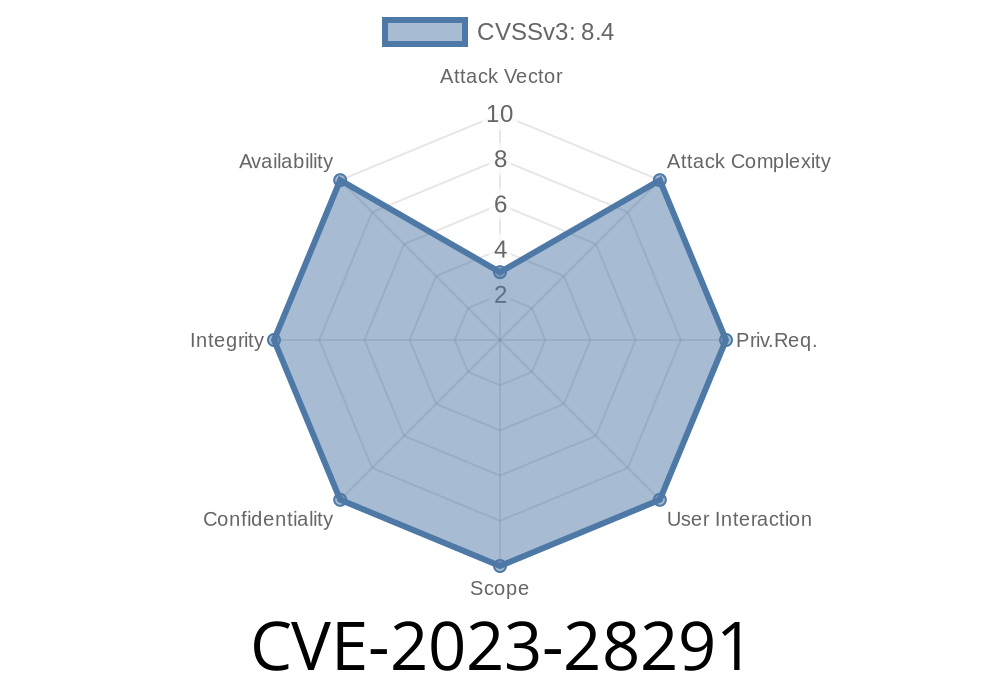In today's digital era, cybercriminals are exploiting vulnerabilities in systems to cause devastation on a massive scale. It's essential for cybersecurity personnel to be aware of these issues and protect their users and organizations from potential breaches. In this blog post, we're diving deep into a relatively new and critical vulnerability known as CVE-2023-28291, which involves the Raw Image Extension and could lead to remote code execution.
Background
CVE-2023-28291 is a severe vulnerability affecting the Raw Image Extension that allows arbitrary code to be executed remotely on a victim's system. This flaw is found in various versions of Windows 10, as well as Windows Server 2016 and 2019. To understand the gravity of this situation, let's dissect some critical aspects of the vulnerability:
1. Raw Image Extension: This is an extension that enables users to view and manipulate raw images captured by digital cameras. A raw image file contains minimally processed data from the image sensor, allowing more control over factors like brightness, contrast, and color balance in post-processing adjustments.
2. Remote Code Execution (RCE): This is a type of cyberattack that allows an attacker to execute arbitrary code on a victim's system without authorization. RCE is considered one of the most dangerous cyber threats, as it grants the attacker complete control over the compromised system.
Vulnerability Details
CVE-2023-28291 is officially categorized as "remote/low skill level to exploit" according to the National Vulnerability Database (NVD). The cause of this vulnerability is improper validation of user input data within the Raw Image Extension, which subsequently leads to memory corruption. As a result, an attacker can exploit this flaw by sending a crafted image file to a vulnerable system, and upon successful triggering of the vulnerability, the attacker can gain control over the affected system.
Attacker crafts a malicious raw image file containing the exploit code.
2. The malicious image file is sent to the victim (via email, instant messaging, or a compromised website).
The following is a hypothetical code snippet demonstrating the vulnerability
#include <stdio.h>
#include <stdlib.h>
void vulnerable_function(char *input) {
char buffer[64];
strcpy(buffer, input); // attacker-controlled data overflows the buffer
}
int main(int argc, char **argv) {
if (argc != 2) {
printf("Usage: %s <raw image file>\n", argv[]);
return ;
}
FILE *fp = fopen(argv[1], "rb");
if (!fp) {
perror("Error opening file");
return 1;
}
fseek(fp, , SEEK_END);
long filesize = ftell(fp);
fseek(fp, , SEEK_SET);
char *input = (char *) malloc(filesize);
fread(input, 1, filesize, fp);
vulnerable_function(input);
fclose(fp);
free(input);
return ;
}
This snippet illustrates a simple example of how the vulnerability can be exploited through a buffer overflow due to improper validation of user input data.
Original References:
For more information and details about the CVE-2023-28291 vulnerability, you can consult the following references:
1. National Vulnerability Database (NVD): The NVD is the U.S. government's repository of vulnerability data that provides technical information, severity ratings, and vulnerability analysis.
2. Microsoft's Security Update Guide: Microsoft has reported this vulnerability and provided a guide on how to tackle it efficiently.
3. CVE Details - The MITRE Corporation: A more comprehensive report on the vulnerability provided by The MITRE Corporation, which manages the CVE program.
Protect Your System
In conclusion, CVE-2023-28291 is a dangerous vulnerability that can have severe ramifications if left unchecked. It is strongly advisable to apply the security patches provided by Microsoft for their products affected by this vulnerability. By doing so, you will be one step ahead in safeguarding your system against cybercriminals trying to wreak havoc on your valuable data and resources.
Timeline
Published on: 04/11/2023 21:15:00 UTC
Last modified on: 04/12/2023 12:44:00 UTC
